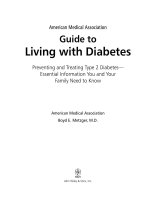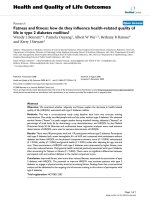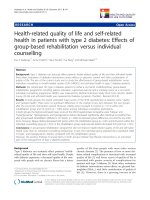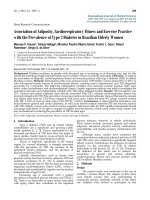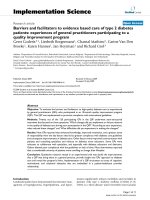Prevalence and associated factors related to type 2 diabetes among Hungyen population aged 25-70 in 2014
Bạn đang xem bản rút gọn của tài liệu. Xem và tải ngay bản đầy đủ của tài liệu tại đây (152.47 KB, 8 trang )
Journal of military pharmaco-medicine no5-2018
PREVALENCE AND ASSOCIATED FACTORS RELATED TO
TYPE 2 DIABETES AMONG HUNGYEN POPULATION
AGED 25 - 70 IN 2014
Nguyen Thi Anh*; Dao Xuan Vinh**; Dinh Hong Duong**
SUMMARY
Objectives: To investigate prevalence and factors associated with type 2 diabetes among
Hungyen population aged 25 - 70 in 2014. Subjects and method: A cross-sectional study was
st
carried on 4,495 subjects aged 25 - 70 of Hungyen province, from 1 February to 30 May 2014
to find out prevalence and factors associated with diabetes. After obtaining written informed
consent, a structured questionnaire was used to collect socio-demographic, lifestyle, and
medical information; anthropometric measurements were taken, and blood samples from finger
tips were drawn to determine glucose level. Association of type 2 diabetes with socio-economic
and lifestyle-related factors was performed using multivariate logistic regression analysis.
Results: Prevalence of type 2 diabetes among Hungyen population was 4.7%. Of 211 diabetes
cases, 139 (65.9%) were female, 118 (84.9%) were over 49 years of age, 118 (84.9%) had a
menstrual disorder, 29 diabetes subjects (13.7%) smoked, 34 (16.1%) consumed alcohol/beer,
31 subjects (14.7%) had at least one brother/sister living with diabetes, 107 (50.7%) raised their
blood pressures, 98 (46.5%) had the history of angina, and 103 (48.8%) had the heart disease.
The association of diabetes with elevated blood pressure, age, and having a family history of
diabetes was statistically significant in multivariate analysis. Conclusion: Approximately 4.7% of
the studied population lived with type 2 diabetes. Elevated blood pressure, age > 49, and having
a family history of diabetes were statistically associated with diabetes. The intervention or/and
control strategy should be focused on people over 49, or having elevated blood pressure, or/
and a family history of diabetes.
* Keywords: Type 2 diabetes; Associated factors; Hungyen; People aged 25 - 70; 2014.
INTRODUCTION
Type 2 diabetes, a global epidemic with
a high socioeconomic cost, is the 4th cause
of mortality among non-communicable
diseases worldwide. It could cause the
reduction of human average lifespans
from 5 through 10 years, the decrease of
life quality, and it also causes blind, kidney
failure, and loss of limbs for the patients
[1, 2].
In 2012, approximately 422 million
people (8.5% of global population) suffered
from, and 1.5 million deaths related to
type 2 diabetes [1]. The prevalence of
type 2 diabetes can be varied according
to countries and geographic regions,
*
**
Corresponding author: Nguyen Thi Anh ()
Date received: 08/03/2018
Date accepted: 23/05/2018
162
Journal of military pharmaco-medicine no5-2018
for example, 1.4% in France, 6.6% in the
US, 8,6% in Singapore, 3.5% in Thailand,
and about 3.01% in Malaysia [2]. The
prevalence of this disease is increasing
gradually, particularly in low and middleincome countries. Overweight and obesity
are proven to be important risk factors for
type 2 diabetes [1, 2].
In 2011, approximately 5 million
Vietnamese people lived with type 2
diabetes, equivalent to 5.0% of the total
population with higher prevalence in
urban regions, a sedentary population
with the habit of eating junk-food or fastfoods. Currently, Vietnam ranked 10th
highest prevalence of diabetes in the
world with a prediction of 8 million cases
in 2025 [3, 4].
Hungyen province, including 9 countryside
districts and only one city, has a
population of approximately 1.2 million. In
recent years, numbers of type 2 diabetes
people are more frequently recorded in
health facilities. According to Hung Yen
provincial preventive medicine center,
nearly 15,344 people were diagnosed
with type 2 diabetes, most of them had a
complication of eyes, neurological system,
lesion of limbs, and kidney damages due
to delayed examinations and treatments.
Thus, this study was conducted to:
Fully understand the prevalence and
associated factors of type 2 diabetes
among the population in Hungyen in 2014,
and look for the opportunities of intervention
and control in the future.
SUBJECT AND METHODS
1. Subject and sample size.
A total of 4,495 participants, aged from
25 -7 0, was invited to participate in this
study. All of them agreed to sign the
consent form, and 4,495 completed profiles
were done.
The descriptive sample size calculation
formulation was used:
Z12 / 2 p(1 p)
n
DE (1)
d2
n: Sample size; 1- : Confidence level,
with 1- = 95%, we got Z1- /2 = 1.96; p:
Anticipated population proportion, we
chose p = 6% [3]; d: Absolute precision
required, we chose d = 0.01; DE: Design
effect (DE = 2); calculated sample size
n = 4,333. In reality, we invited 4,495
people to participate in this study.
* Place and time: This study was
carried out in 9 districts and 01 city of
Hungyen province, Vietnam from 1st
February to 30 May 2014.
2. Methods.
A cross-sectional study was carried on
4,495 subjects aged 25 - 70 of Hungyen
province, from 1st February to 30 May
2014 to find out prevalence and factors
associated with diabetes. After obtaining
written informed consent, a structured
questionnaire was used to collect sociodemographic, lifestyle, and medical
information; anthropometric measurements
were taken, and blood samples from
finger tips were drawn to determine
glucose level. Association of type 2
163
Journal of military pharmaco-medicine no5-2018
diabetes
with socio-economic and
lifestyle-related factors was performed
using multivariate logistic regression analysis.
* Anthropometrical measurements:
Body weight is measured to the
nearest 0.1 kg using SECA scale, and
height is measured to the nearest 0.1 cm
by using a wooden ruler. BMI is
calculated as weight (kg) divided by
height (m) squared (kg/m2), it can be
classified as BMI < 18.5 underweight,
18.5 ≤ BMI < 25.9 normal, 26 ≤ BMI
< 29.9 overweight, BMI ≥ 30 obesity.
* Glucose concentration: Concentrations
of glucose were determined by an autoanalyzer (Accu-Check).
* Questionnaire: The structured
questionnaire is composed of closed
questions with regard to socio-demographic
profiles (age, sex, and occupations),
lifestyle-related
factors
(alcohol/beer
consumption, smoking, physical activities,
and dietary/nutrient status), and medical
history (dyslipidemia, elevated blood pressure,
heart diseases, and obesity status).
* Data analysis: Data were managed
by using Epi.info 7.0 and all statistical
analyses were carried out by using
STATA v.14 (STATA Corp).
Data were summarized by using
frequency and proportion for categorical
variables, and mean and standard
variation/median and interquartile range
for continuous variables.
After checking for normal distribution,
independent - sample t-test or Mann Whitney U test was used as appropriate
164
to compare continuous variables. Pearson’s
χ2 test or Fisher’s exact test was performed
to compare frequencies of categorical
variables.
Univariate logistic regression analysis
was used to assess potential factors
associated with diabetes, and multivariate
logistic regression analysis was performed
to test the associations of type 2 diabetes
with potential associated factors. Data are
expressed as odds ratios with 95 percent
confidence intervals (95%CI). A p-value of
< 0.05 is considered statistically significant.
* Ethical issue: Ethical approval has
been obtained from the Ethical Review
Board of the Military Medical University.
RESULTS AND DISCUSSION
* The characteristics of study population:
- Sex: 1,411 (31.4%) were male; female:
3,084 (68.6%).
- Age: 1,789 people (39.8%) aged from
50 - 59.
- Marital status: 4,141 (92.1%) were
married.
- BMI: 574 people (17.1%) were overweight.
- Occupations: 2,687 people (59.8%)
were farmer, 619 people (13.8%) did not
have a permanent job, and 391 people
(9.7%) were workers.
- Literacy levels: 2,384 participants
(53%) finished secondary school, and
1,406 (31.2%) had high-school or higher
level of literacy.
Journal of military pharmaco-medicine no5-2018
Table 1: Characteristics of the studied cohort and prevalence of type 2 diabetes.
Total
(N1 = 4,495)
Variable
n1
%
Male
1,411
Female
3,084
Diabetes
(N2 = 211)
n2
%
n2/N1
31.4
72
34.1
5.1
68.6
139
65.9
4.5
Sex (male)
Age groups
25 - 39
388
8.6
5
2.4
1.3
40 - 49
1,057
23.5
31
14.7
2.9
50 - 59
1,789
39.8
82
38.8
4.6
60 - 70
1,261
28.1
93
44.1
7.4
367
10.9
17
8.1
4.6
2,139
63.8
92
43.6
4.3
23 ≤ BMI < 25
574
17.1
64
30.3
11.1
BMI ≥ 25
274
8.2
38
18.0
13.9
4,141
92.1
187
88.6
4.5
Separated/divorced
43
0.9
1
0.5
2.3
Widow
245
5.5
19
9.0
7.8
Never married
66
1.5
4
1.9
6.1
Il-literacy
15
0.3
2
0.9
13.3
Reading & writing (+)
179
3.9
15
7.1
8.3
Primary school
511
11.4
26
12.3
5.1
Secondary school
2,384
53.0
115
54.5
4.8
High-school & higher
1,406
31.2
53
25.1
3.8
BMI
BMI < 18.5
18.5 ≤ BMI < 23
Marital status
Married
Literacy levels
Occupations
Office holder
296
6.6
9
4.3
3.04
Free jobs
619
13.8
23
10.9
3.71
Farmer
2,687
59.8
136
64.5
5.06
Worker
391
8.7
9
4.3
2.30
Student
4
0.1
0
0
0
Housewives
134
3.0
6
2.8
4.47
Retired
233
5.2
26
12.3
11.1
Elderly
131
2.9
2
0.9
1.52
Prevalence of type 2 diabetes in Hungyen was 4.7%. It was about 4.5% in the
female, and slightly higher, about 5.1% in the male group. According to Phuong P.H et
165
Journal of military pharmaco-medicine no5-2018
al (2012), the prevalence of diabetes was 5.5% of the population aged from 30 - 69
(5.9% in males versus 5.1% in females) [5]. Dang T.H et al (2005) found that 5.7% of
females and 2.9% of males in Quynhon city were suffering from diabetes [6]. The
number of females acquired type 2 diabetes is increasing gradually due to the risk of
obesity, and female hormones as well.
Regarding age groups, we found that the prevalence of diabetes raised accordingly
to age. It was 1.3% in group from 25 - 39, 2.9% in group 40 - 49, 4.6% in group 50 - 59,
and 7.4% in group 60 - 70. Differences between age groups regarding diabetes’
prevalence are statistically significant (p < 0.01). Our results are similar in compared
with findings of other studies on diabetes in Vietnam [7, 8].
Table 2: Geographic distribution of studied participants.
Diabetes
(n = 211)
Total
(n = 4,495)
Districts/City
n
%
n
%
Phucu
502
11.2
20
9.5
Anthi
501
11.1
13
6.2
Khoaichau
501
11.1
26
12.3
13.3
Vangiang
509
11.3
28
Yenmy
500
11.1
17
8.1
Vanlam
509
11.3
36
17.1
Tien Lu
357
7.9
17
8.1
Kimdong
323
7.2
8
3.8
Myhao
422
9.4
35
16.6
Hungyen city
371
8.3
11
5.2
4,495
100.0
211
100.0
Total
Regarding geographic distribution, Vanlam and Myhao districts had the highest rate
of type 2 diabetes, at nearly 17.1%, followed by Khoaichau and Vangiang districts
(approximately 13%). The low rates of diabetes were seen in Kimdong district (3.8%)
and Hungyen city (5.2%).
Table 3: Association of type 2 diabetes with some socio-demographic, lifestyle,
medical, and family history factors.
Diabetes
(n = 211)
Variables
No diabetes
(n = 3,143)
**
OR , 95%CI; p
n
%
n
%
Female
139
65.9
2,178
69.3
0.9 (0.6 - 1.1); 0.30
Age > 49
118
84.9
1,363
62.6
3.36 (2.1 - 5.4); 0.00
No child
5
3.7
112
5.10
0.7 (0.3 - 1.7); 0.40
166
Journal of military pharmaco-medicine no5-2018
Newborn baby > 3.6kg
31
23.1
542
26.2
0.8 (0.6 - 1.3); 0,43
Menstrual disorder
118
84.9
1,512
69.4
2.5 (1.5 - 4.0); 0,00
Smoking
29
13.7
515
16.4
0.8 (0.5 - 1.2); 0.31
Alcohol/beer drinking
34
16.1
557
17.7
0.9 (0.6 - 1.3); 0.55
Family history (brother/sister
having diabetes)
31
14.7
183
5.80
2.8 (1.8 - 4.2); 0.000
Raised BP*
107
50.7
904
28.8
2.5 (1.9 - 3.4); 0.000
Raised systolic BP
85
40.3
624
19.9
2.7 (2.0 - 3.6); 0.000
Raised diastolic BP
85
40.3
774
24.6
2.0 (1.5 - 2.8); 0.000
Heart disease
103
48.8
1,426
45.4
1.1 (0.9 - 1.5); 0.33
Stroke
3
1.4
23
0.70
2.0 (0.6 - 6.6); 0.27
Angina
98
46.5
1,318
41.9
1.2 (0.9 - 1.6); 0.2
Heart failure
3
1.4
45
1.40
1.0 (0.3 - 3.2); 0.9
Overweight
180
85.3
2,842
90.4
1.4 (1 - 1,8); 0,03
Habits
Medical history
(* BP - blood pressure; **: OR: Odds ratio)
Among diabetes population, 139 (65.9%) was female, 118 (84.9%) over 49 years of
age, 118 (84.9%) had a menstrual disorder which higher than those in non-diabetes
group (p < 0.05). Approximately 29 diabetes subjects (13.7%) smoked, 34(16.1%)
consumed alcohol/beer, 31 subjects (14.7%) had at least one brother/sister living with
diabetes. There were 107 diabetes people (50.7%) who raised their blood pressures,
98 (46.5%) had a history of angina and 103 (48.8%) had a heart disease.
It can be seen obviously that female, over 49 years of age, menstrual disorder, and
raised blood pressure are associated with type 2 diabetes. The differences were
statistically significant (p < 0.05)
Table 4: Association between type 2 diabetes and some factors in univariate and
multivariate logistic regression analysis.
Variables
Univariate analysis
Multivariate analysis
OR
p
OR
p
Elevated blood pressure
2.50
0.000
2.60
0.000
Age > 49
3.36
0.000
2.46
0.003
Menstrual disorder
2.50
0.000
1.23
0.490
Sister/brother with diabetes
2.80
0.000
3.07
0.000
Don’t know risk related ages
1.30
0.010
0.81
0.470
167
Journal of military pharmaco-medicine no5-2018
Don’t know overweight risk
1.30
0.001
0.98
0.900
Eating > 3 meals/day
2.20
0.010
1.67
0.260
Too much food consumption
0.50
0.010
0.54
0.102
No eating fish
1.60
0.002
1.50
0.060
No eating eggs
1.50
0.004
1.16
0.470
Less fruits consumption
1.60
0.002
1.40
0.120
Besides heart diseases and metabolic
syndrome, type 2 diabetes is proven to be
highly associated with lifestyle factors
(smoking, drinking alcohol/beer, lack of
physical activities), dietary (too much food
consumption, particularly, fatty and skin of
animals, less eating fishes, using cooking
oils, and eating fewer vegetables/fruits),
and family history of diabetes.
Approximately 13.7% diabetes people
smoked cigars, and 16.1% of them drank
beer/alcohol. Our results show that they
(diabetes people) prefer using animal oils
in preparing foods, eating meat plus skins,
they ate fewer fishes, bean, and
vegetables in comparison with nondiabetes people. It is suitable with the
finding of Binh T.V. (2007), people with a
habit of eating animal fat have 6 times
higher risk of getting type 2 diabetes
compared to those who did not have that
habit [8].
In our study, overweight and obesity
people had 1.4 times higher risk of
acquiring type 2 diabetes compared to
normal BMI group, 95% CI (1 - 1.8),
p < 0.001. People with elevated blood
pressure have 2.5 times higher risk of
being diabetes 95%CI (1.9 - 3.4);
p < 0.001. People who have a family
168
member (brother or sister) living with
diabetes will have 2.8 times higher risk of
developing diabetes, 95%CI (1.8 - 4.2), p
< 0.001. According to the result of
Phuong C.M’ study, 46.8% of diabetes
people have at least one family member
suffering from diabetes, much higher than
those without, just 28.2% [4].
Regarding female population with
diabetes, we found that 97.2% of women
had a history of having new-born baby’s
weight > 4,000 grams. Chien H.V study’s
result on 1,880 subjects in Thaibinh
province, found that 22.2% of women with
a history of giving baby over 4,000 grams
suffered from diabetes [9].
We also found that type 2 diabetes is
significantly associated with following
factors such as elevated blood pressure,
age > 49, the menstrual disorder, a family
history of diabetes, lacking of knowledge
about risks of diabetes (age, overweight),
eating > 3 meals/day, too much food
consumption, no eating fish and eggs,
and less fruits consumption, with p < 0.05.
The multivariate regression analysis
proved that elevated blood pressure, age
> 49, and having a family history of
diabetes were significantly associated
with type 2 diabetes (p < 0.005).
Journal of military pharmaco-medicine no5-2018
CONCLUSION
There was about 4.7% of the studied
population living with type 2 diabetes, of
those, the farmer was accounted for
64.5%, about 84.9% was over 49 years of
age, and 50.7% had raised blood
pressure. Multivariate analysis proved
that elevated blood pressure, age > 49,
and having a family history of diabetes
were significantly associated with diabetes.
The intervention or control strategy should
be focused on the group of people over
49 years, having high blood pressure, and
having the family history of diabetes.
REFERENCES
1. WHO. Global report on diabetes, Geneva.
2016.
2. Center for Disease Control and Prevention.
Get the facts on diabetes. CDC - Info, Atlanta,
GA 30333. USA. 2011.
3. Lanh N.V. Diabetes in the age group of
40 - 69 in Ngabay town, Haugiang province.
Vietnam Practical Medicine Journal. 2011, No
5, pp.124-126.
4. Phuong C.M. Results of populationbased intervention on diabetes type 2 in
Caungang district, Travinh province. Ph.D.
thesis. Hue University. 2012.
5. Phuong H.P, Toa L.Q et al. Prediabetes and type 2 diabetes in Quang Ngai
province in 2011”, Journal of Endocrine
th
Diabetes, 6 National Endocrine Diabetes
conference. Hue, 2012,1(6), pp. 48-57
6. Dang T. H., Thuan H. X., et al.
Prevalence of diabetes among Quynhon
people aged over 30 in 2005. The full text of
rd
scientific topics, 3 Vietnam Endocrine and
Metabolism Conference. Medicine Publisher.
2005, p.648.
7. Hai T.V, Xuan N.M et al. Risk factors of
diabetes among out-patients of Thanhnhan
Hospital, Hanoi. Vietnam Practical Medicine
Journal, 2006, No 548, pp.93-94.
8. Binh T.V, Huyen N.T.N et al.
Assessment of the prevalence of diabetes and
risk factors in an urban district and a
countryside district in Hanoi. The full text of
rd
scientific topics, 3 Vietnam Endocrine and
Metabolism Conference. Medicine Publisher.
2007, pp.617-627.
9. Chien V.H et al. Prevalence and
associated factors of type 2 diabetes in some
regions of Thaibinh province. The full text of
rd
scientific topics, 3 Vietnam Endocrine and
Metabolism Conference. Medicine Publisher.
2007, p.490.
169


